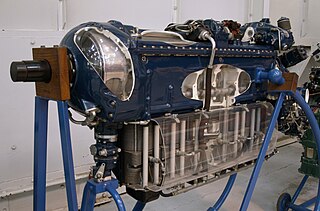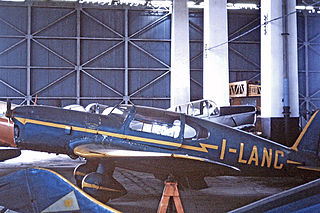Related Research Articles

The de Havilland Gipsy Major or Gipsy IIIA is a four-cylinder, air-cooled, inverted inline engine used in a variety of light aircraft produced in the 1930s, including the famous Tiger Moth biplane. Many Gipsy Major engines still power vintage aircraft types worldwide today.

The Percival Prentice was a basic trainer of the Royal Air Force in the early postwar period. It is a low-wing monoplane with a fixed tailwheel undercarriage. Front seating was in a side-by-side configuration with a rear seat provided.

The Boulton Paul Balliol and Sea Balliol are monoplane military advanced trainer aircraft built for the Royal Air Force (RAF) and the Royal Navy Fleet Air Arm (FAA) by Boulton Paul Aircraft. Developed in the late 1940s, the Balliol was designed to replace the North American Harvard trainer. It used the Rolls-Royce Merlin engine. The Sea Balliol was a naval version for deck landing training.

The Handley Page HP.115 was a British delta wing research aircraft built by Handley Page to test the low-speed handling characteristics to be expected from a supersonic airliner of slender delta configuration. It formed part of the British supersonic aircraft research programme, carried out in the 1960s and sponsored by the Ministry of Supply, that eventually produced the Concorde.

The Miles M.38 Messenger is a British four-seat liaison and private owner aircraft built by Miles Aircraft.

The Boulton Paul P.92 was a British design by Boulton Paul for a two-seat turret-armed fighter/ground attack aircraft to meet Air Ministry Specification F.11/37. Only a half scale prototype – the P.92/2 – was built and tested as check on aerodynamics before the project was cancelled in 1940.

The de Havilland Gipsy Queen is a British six-cylinder aero engine of 9.2 litres (560 cu in) capacity that was developed in 1936 by the de Havilland Engine Company. It was developed from the de Havilland Gipsy Six for military aircraft use. Produced between 1936 and 1950 Gipsy Queen engines still power vintage de Havilland aircraft types today.

The Auster J/5 Autocar was a late 1940s British single-engined four-seat high-wing touring monoplane built by Auster Aircraft Limited at Rearsby, Leicestershire.

The Percival Merganser was a light, civil transport of the late 1940s. It was a twin-engine, high-wing monoplane of all-metal, stressed skin construction with retractable tricycle undercarriage.
The Handley Page Basic Trainer (H.P.R.2) was a British training aircraft of the 1940s. It was a single-engine, low-wing monoplane with a fixed tailwheel undercarriage.

The Ambrosini SAI.2S was a four-seat light aircraft produced in Italy shortly before World War II.

The Blackburn Bluebird IV was a single-engine biplane light trainer/tourer biplane with side-by-side seating designed by Blackburn Aircraft. It was an all-metal development of the wooden Blackburn Bluebird I, II and III aircraft.

The Miles M.2 Hawk was a 1930s British two-seat light monoplane designed by Miles Aircraft Limited.

The Miles Hawk Major was a 1930s British two-seat light monoplane developed by Miles Aircraft from the Miles Hawk.

The Reid Rambler, later known under the Curtiss-Reid brand after Reid was purchased by Curtiss, was a biplane trainer/sport aircraft built in Canada in the early 1930s and used in small numbers as a trainer aircraft by the Royal Canadian Air Force.

The Miles M.65 Gemini was a British twin-engined four-seat touring aircraft designed and built by Miles Aircraft at Woodley Aerodrome. It was the last Miles aircraft to be produced in quantity.

The de Havilland C.24 was a two-seat autogyro built by de Havilland at its Stag Lane works in England in
The VEF I-15 was a Latvian advanced trainer aircraft of the 1930s. Two examples of the I-15, a small, single-engined monoplane were built by the VEF to the designs of Kārlis Irbītis and were used by the Latvian Air Force

The Breda Ba.33 was an Italian light sport aircraft designed and built by the Breda company.

The CASA III was a 1920s Spanish two-seat monoplane, designed by Luis Sousa Peco and built by Construcciones Aeronáuticas SA (CASA) at Getafe near Madrid.
References
- 1 2 3 Brew, Alec (1993). Boulton Paul aircraft since 1915 . London: Putnam. pp. 341-342. ISBN 0-85177-860-7.